|
January 2004
How did I take this digital picture •
With my new, FREE, HP620 Digital Camera, that's how! Well, it was sort of free - it first required a little repair. |
|
|
Luckily the smoke was not from the camera, but from one of the batteries that was shorted by a dislodged battery contact. New batteries revealed the camera electronics seamed to be OK, but each time the camera was turned on a loud buzz could be heard from within the lens and the lens did not extend as it should have. The LCD display would then display 'Error Code 106' for a few seconds before the camera turned itself off. It was obvious that something was preventing the lens motor from turning so the next step was obvious - the camera had to be disassembled for further investigation. |
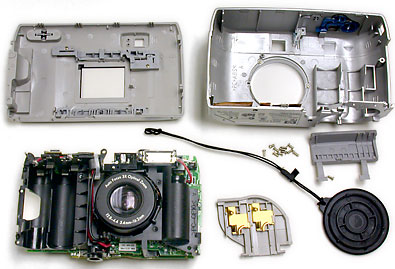 |
 |
I never considered taking the camera to a service center for repair. The camera's owner had already done that and was told what I already knew, that a new camera would be less expensive than any repair. (Makes one wonder why service centers still exist!) But I did send the HP Total Care on-line service center an e-mail as I was curious what error code 106 indicated. HP replied: 'Error code 106 occurs due to internal sensor misread. As the camera was dropped, some internal issue may have occurred with the internal sensors of the camera. I recommend that you call the HP Total Care Center'. The error code didn't help much in this case except to explain how the jammed lens condition was detected. It would be nice if HP (and others) would simply make more of their service info available on-line. If nothing else, it would be interesting to at least see the entire error code listing of detectable conditions. |
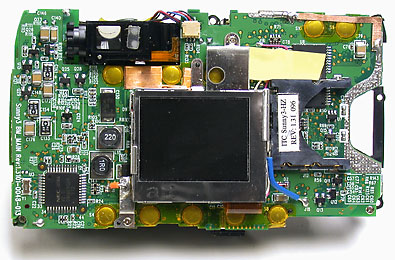 Rear of main PC board and LCD screen. |
|
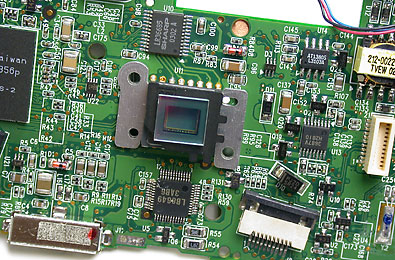 |
Removing the lens revealed the CCD sensor and now only the lens remained to be disassembled. I have tried to disassemble and repair a few lenses in the past, but something always seems to prevent successful reassembly, like being small enough to fit inside to attach that last clip or spring. I had nothing to loose, as it didn't work the way it was, so proceeded with the fun and disassembled the lens. |
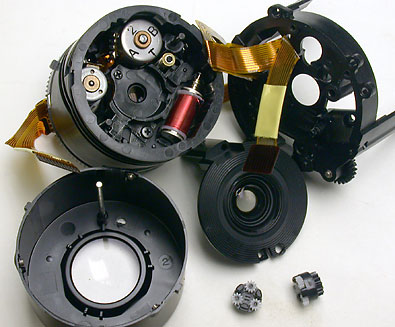 Looking for a tiny motor? I now know where to find one! |
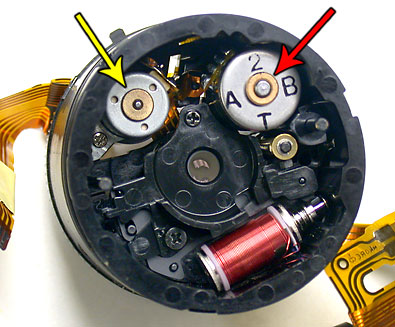 Yellow arrow points to the tiny 3/8" dia. motor. Red arrow points to one of the two solenoids. |
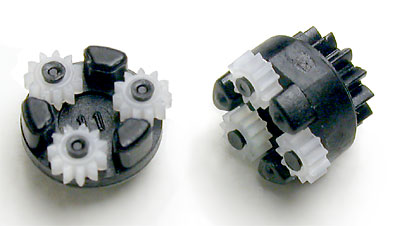 |
Problem found. The tiny motor is held by a single screw through a mounting ear on one side of the motor. Force resulting from the impact had bent the motor's mounting tab which caused the motor's gear to jam up in the mating planetary speed reduction gears. Straightening the motor's mounting tab fixed the problem. Now all that I had to do was put it all back together. (Left) Tiny planetary speed reduction gears. Assembly is only 1/4" in diameter. |
|
Pressed into the plastic lens parts were many small metal pins that adjust lens sections when the lens is focused or zoomed by following channels in other parts. It was a challenge to find the proper assembly order to get each pin into the proper channel. To complicate matters, the impact had dislodged several of these tiny pins that mysteriously appeared on my workbench while reassembling the lens. It took several minutes to first figure out what these pins were and then where they belonged. When everything was back together I discovered a new problem - 5 tiny screws on the workbench that belonged somewhere in the camera. Even though the camera was basically working, it would occasionally display an error code and shut down while zooming. I quickly realized that some of the screws were from deep inside the lens which meant another complete disassembly of the camera. (Murphy never sleeps!) I now have a new digital camera after about 10 hours of puzzle solving. Some may feel spending this much time to repair an item is crazy, considering that it takes less time to simply earn enough money to replace it. But they see nothing abnormal about spending as much, or more, time solving cross-word or jigsaw puzzles that they simply discard or take apart when done. I think solving "what's wrong with this dam thing", "how do I get this son-of-a-b open" and "how the heck does this thing go together" puzzles are much more interesting and rewarding! |
|
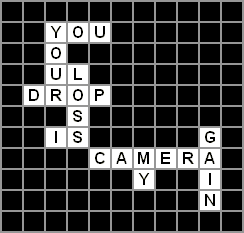 |
 |
|
This may cost me future free cameras, but since I'm such a nice guy (who can't resist giving those who have dropped their cameras a hard time), here is a tip. Instead of fighting with your camera strap to keep it from dangling in front of the lens, simply place it around your wrist. This will also save your camera from a fatal fall the next time you are on a building, cliff, boat, bridge, hot air balloon, or whatever, when (not if) it slips from your hand! Update - September 2004 I have received several emails from others with similar problems. One wrote:
Several who dropped their HP620 camera have emailed me since this page was created and considering that -
Just How Many Clumsy People Are There? And just how many cameras and other delicate hi-tech devices have they destroyed? Update - November 2005 Several more have emailed about their cameras, but not everyone admits responsibility.
Like many of my pages, this page is simply a collection photos and comments that I hope others find interesting and perhaps even useful for whatever. I am not a camera expert and, other then what you see on this page, can't help much with camera repairs so it was nice to finally hear from someone that was not looking for help to fix a camera, but rather to let me know that my page helped at least one person to successfully repair their camera.
Thanks Bryan, and congratulations on the repair. |
|
|

